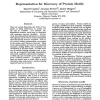Free Online Productivity Tools
i2Speak
i2Symbol
i2OCR
iTex2Img
iWeb2Print
iWeb2Shot
i2Type
iPdf2Split
iPdf2Merge
i2Bopomofo
i2Arabic
i2Style
i2Image
i2PDF
iLatex2Rtf
Sci2ools
ISMB
1993
1993
Representation for Discovery of Protein Motifs
There are several dimensions and levels of complexity in which information on protein motifs may be available. For example, onedimensional sequence motifs may be associated with secondary structure identifiers. Alternatively, three-dimensional information on polypeptide segments may be used to induce prototypical three-dimensional structure templates. This paper surveys various representations encountered in the protein motif discovery literature. Many of the representations are based on incompatible semantics, making difficult the comparison and combination of previous results. To makebetter use of machine learning techniques and to provide for an integrated knowledge representation framework, a general representation language -in which all types of motifs can be encoded and given a uniform semantics -- is required. In this paper we propose such a model, called a spatial description logic, and present a machine learning approach based on the model.
Computational Biology | ISMB 1993 | Onedimensional Sequence Motifs | Protein Motif | Prototypical Three-dimensional Structure |
| Added | 02 Nov 2010 |
| Updated | 02 Nov 2010 |
| Type | Conference |
| Year | 1993 |
| Where | ISMB |
| Authors | Darrell Conklin, Suzanne Fortier, Janice I. Glasgow |
Comments (0)

